
Monty tells us that although a lot of us may have Japanese Gardens or at least Japanese plants like Maple, cherries and Hosta.
Not a lot of us really know them, its an enigma.

In Monty Don's Japanese Gardens, Monty wants to get to the heart of the Japanese Garden, and Japan which has some of the most beautiful gardens in the world.
In Monty Don's Japanese Gardens episode 2, he visits Japan in the autumn.
Monty starts his journey in the Japanese Autumn in Kenroku-en Gardens, where he visited first in the spring for the glorious cherry blossom.

Mr Shishima the Head Gardener told Monty to return in Autumn and the garden is glowing with autumn colour.
Kenroku-en was once a private garden of the Maeda clan, first created in 1670, as the grounds to the castle. It was made into a public park in 1874.
The gardens are very labour intensive, even more so with the autumn leaves and the moss is still being hand weeded.

There are many different types of Maple in Japan but they all have the same stunning colouration of yellow, orange and red.


Monty wants to learn about yukitsuri, where the Niwaki trees are strung with string to protect them against the snow that is to come.
Mr Shishima, Head Gardener takes Monty to show him how it is done.


Monty remembers the knot whilst swaying on the ladder and its passes inspection as he chops off the remaining rope.
This process takes a whole month to complete with over 500 gardeners protecting 800 trees.
The ropes will stay on the trees until March, when the threat of snow has gone.
Monty talks about how when he first visited the struts supporting the trees seemed to dominate them.
Now he can see that they, as well as the ropes are just as an important part as the branches they protect in the garden, and why they are celebrated.
Monty has enjoyed his autumn return visit and how its great to see people out and about enjoying the gardens.

Monty continues his journey around Japan and moves next to Kyoto.
When he first visited he looked into the history. Boating gardens, moss zen gardens and tea gardens were all enjoyed by Monty.
Monty next part of the journey takes him back to the 17th Century during the Edo period.

Nijo Castle in the centre of Kyoto and built in 1603.
The castle was built during a period of peace where gardens were starting to become an important feature.

The emperor visited in 1626, meaning that the garden was completely rebuilt.
The castle was also enlarged ahead of his visit for the shogun to show off his power.
A new palace was built just to admire the new pond and rocks water feature.
All that is left of the palace is a few bits of the foundations.

Monty tells how all the stones in the garden are placed with 'exquisite precision' even though they are enormous!

Monty is off next to Tokyo too explore some stroll gardens.

Stroll gardens were different from the very static rock gardens and the tea gardens with a path that just leads to the tea house.
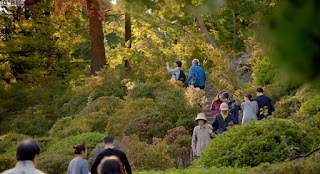
The Stroll gardens have meandering paths leading to view points and were created for the rich Samurais to show their power and money.
In 1938 the garden was donated to the Government who turned it into a public park after centuries of being in private hands.
Rikugi-en name is based on the 6 principles of poetry in China.
The layout is based on the scenery of the Bay of Poetry in the book the Classic of Poetry.
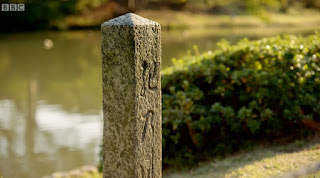
Monty met with the local tour guide who explained to him about the 88 stone markers around the garden represent the 88 scenes to view.

They go into the mats in the winter and are burnt in March.
Monty is moving on to 20th Century Stroll gardens.

Monty off to see what you would traditionally think to be just another Japanese Garden.
Up some stones steps and you are treated to a traditional English garden.
Kyu-Furukawa Rose Garden was designed by Josiah Conder in 1917 he had moved to Japan to become a professor of Architecture.

They are pruned back hard in May after the first flowering.

There are lots of well known roses in the gardens.

She explains that theses are rare and they take delight from them.
So Monty asks why are they then not in Japanese gardens.
She explained that Japanese gardens are not 'showy' and are more subdued.
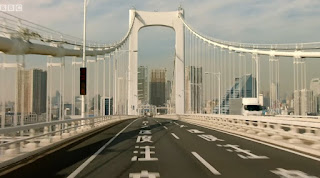
Monty next stop is to a suburb of Tokyo called Kawaguchi for a garden centre pit stop! We have all done that when we spot one Pete Free🌻




The stroll garden path takes you through changing views, with rocks, water and trees and stunning borrowed landscapes.
The garden is an acre in size but the borrowed landscape makes it seem larger.

The garden features elements of Japanese and British design including mown lawns.
The lawn is hard to grow next to the traditional moss but in this garden they combine very well.

He stipulated where the water features were to be, next to the road and the Lake Biwa canal.

The Emperor sent 2 pine trees to go outside the newly constructed tea house that rose like dragons through the clouds and a photo was sent to thank him.

All that is left now are markers where the original pines were and new ones growing in their places.
The gardeners prune the top of the trees to make full use of the borrowed landscape and this gives them the illusion of being so much larger from a distance.

Monty next garden also makes use of its borrowed landscape.



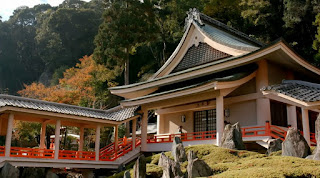
The Kyokusii Garden started being constructed in 1973 when the shrine had some new buildings constructed.
The garden was based on the ancient Chinese legend of the windy stream with cups of Saki put into the stream to reach poets downstream.


He first saw the garden just after construction and the rocks were very white and shiny set in concrete.

Monty ends with saying 'so a new garden eventually becomes an old garden'.
Shingemori died before the garden was finished so his son took over his work.
Monty finishes by saying the priest told him some people say its not a proper Japanese garden, that is more like modern art. Monty thinks that's 'high praise'.
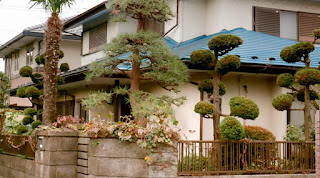
38 million people live in Tokyo! A garden is a rare luxury!
One way to get round this is, to shrink everything.
Bonsai is what everyone associates with Japan.

Monty visits Bonsai-mura or Bonsai Village.
There are different regional styles of Bonsai, but its the careful pruning that leaves it looking like a miniature tree that could be hundreds of years old.
Monty is here to see Mr Hiroshi Takeyama, Third generation Master at Omiya Bonsai Village.
Mr Takeyama has given the great honour of giving Monty a pruning lesson.
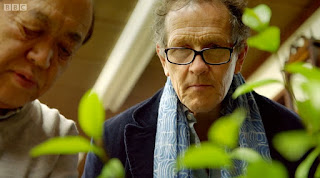
Mr Takeyama shows Monty what bits need trimming right to the base and what needs reshaping.
Then its Monty turn.
He seems impressed.

Mr Takeyama explains the aim is for a triangular shape and for it to look like that from all sides.
Monty was pleased with his entry level lesson and talks about he can see why Bonsai is popular as it is small but its not modern.

Monty goes in search of 'modern' Japanese style of gardening.
Monty goes for a lesson in Kokedama or moss balls with Chie Kishimoto at Rinha Bonsai.

Kokedama is getting increasing popular so Monty asks for a lesson, although he does not look too comfortable.
Chie explains how you have to use a special type of moss.
You then wrap it round the plants and sprinkle it with charcoal to help the moss grow.
Monty then makes it into a ball shape in his hand and wraps it with cotton which will later dissolve.

A chopstick is used to push the cotton end into the moss.
There are very few opportunities for new public gardens but the Government have started to do something about this.

There is now in place a law to green up Tokyo with large buildings having to have 20% green spaces mostly roof gardens.
Monty visits one such roof garden on top of a new shopping centre that has a strange mix of plants but still a much need green space.

Next flying visit (sorry!) is to the main departure lounge at Haneda Tokyo main airport.
It was designed by a well known Chelsea Flower Show gardener Mr Kazuyuki Ishihara winner of 10 Gold Medals.

The garden was built in 2011 after the earthquake and was based on Mr Kazuyuki's Chelsea Garden and brings an oasis of calm.
Monty met with Mr Kazuyuki who originally wanted maples and cherry blossom for the garden but they were not suitable for the environment.
Monty asks about the maintenance for the 7 year old garden (at time of programme). It is all done at night.
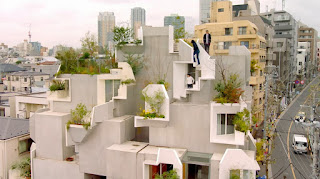
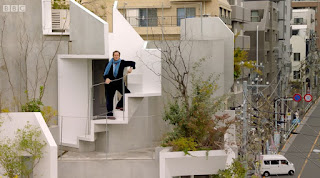
Having the stairs externally makes you go on an adventure outside.

'The house is organic and grown, like a tree, he gets lost in the forest'.
He spends all seasons there it is very refreshing'.
Monty says there 'a strong core of tradition in this building'.
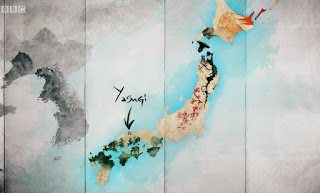
Feeling a bit overwhelmed Monty heads for his last garden in Yasngi
Monty is here to see a garden that contains all the parts of the other gardens he has visited in one garden.
Adachi Museum of Art garden has been voted the most beautiful garden in Japan.

There are elements from every Japanese garden, moss, zen, gravel, borrowed landscapes, stroll gardens and maple trees.


The garden can only be viewed from inside the building and there is no access to it, so it is all based on the one view like a painting.

Monty meets again with Professor Suzuki, a cultural expert on Japanese gardens.
Monty asks about the philosophy behind the garden.
It is the typical landscape of Japan, in miniature at the sea side, bright sun, ocean pine trees, very calm, modern landscape.
A 'mindscape'.
Monty likes the 'mindscape' and says how its a series of pictures being viewed from the one landscape.

Monty comes to the end of his journey with a well deserved sit down and a recap!
Monty talks about modern Japan having awareness of its history and still a love of nature and a living delight of it in its gardens.
All photographs are copyright of BBC.com
Monty Don's Japanese Gardens Book
Japanese Gardens: a Journey
Monty Don & Derry Moore
Share this post
Not a lot of us really know them, its an enigma.

In Monty Don's Japanese Gardens episode 2, he visits Japan in the autumn.
Monty starts his journey in the Japanese Autumn in Kenroku-en Gardens, where he visited first in the spring for the glorious cherry blossom.

Mr Shishima the Head Gardener told Monty to return in Autumn and the garden is glowing with autumn colour.
Kenroku-en was once a private garden of the Maeda clan, first created in 1670, as the grounds to the castle. It was made into a public park in 1874.
The gardens are very labour intensive, even more so with the autumn leaves and the moss is still being hand weeded.

In autumn there is also a celebration of trees but this time it is the colouration of the Maple trees with their magnificent autumn displays.
There are many different types of Maple in Japan but they all have the same stunning colouration of yellow, orange and red.

The air is festive, people are out and about in the good weather to enjoy the season.
Momijigari is the term used for these festivities and means 'red leaf hunting'.
The couple above are having their wedding photos taken although they are not marrying until next spring.
Momijigari is the term used for these festivities and means 'red leaf hunting'.
The couple above are having their wedding photos taken although they are not marrying until next spring.

Monty wants to learn about yukitsuri, where the Niwaki trees are strung with string to protect them against the snow that is to come.

After bamboo poles are tied to the trunk, rice straw ropes are then lowered from the top.
The ropes are then tied to the branches to prevent them breaking under the weight of the snow.
The ropes are then tied to the branches to prevent them breaking under the weight of the snow.
With the team of gardeners making it look so easy Monty can not turn down the honour of being asked to 'have a go'. So up the ladder he goes.
After being shown the correct knot to use and 'donning' some real Japanese secateurs in a very tight belt.

Monty remembers the knot whilst swaying on the ladder and its passes inspection as he chops off the remaining rope.
This process takes a whole month to complete with over 500 gardeners protecting 800 trees.
The ropes will stay on the trees until March, when the threat of snow has gone.
Monty talks about how when he first visited the struts supporting the trees seemed to dominate them.
Now he can see that they, as well as the ropes are just as an important part as the branches they protect in the garden, and why they are celebrated.
Monty has enjoyed his autumn return visit and how its great to see people out and about enjoying the gardens.

When he first visited he looked into the history. Boating gardens, moss zen gardens and tea gardens were all enjoyed by Monty.

Nijo Castle in the centre of Kyoto and built in 1603.
The castle was built during a period of peace where gardens were starting to become an important feature.
The gardens are a display of the shoguns power.

The emperor visited in 1626, meaning that the garden was completely rebuilt.
The castle was also enlarged ahead of his visit for the shogun to show off his power.
A new palace was built just to admire the new pond and rocks water feature.
All that is left of the palace is a few bits of the foundations.

The pond has three islands.
The Island of the Immortals, Crane Island and Turtle Island.
The Island of the Immortals, Crane Island and Turtle Island.
Monty tells how all the stones in the garden are placed with 'exquisite precision' even though they are enormous!
These gardens are again full of people out enjoying the season.
The people are looking at the maples in their full autumn colour, browsing the stalls selling goods or enjoying traditional tea in the gardens.
The people are looking at the maples in their full autumn colour, browsing the stalls selling goods or enjoying traditional tea in the gardens.

Monty is off next to Tokyo too explore some stroll gardens.
Over the periods there has been many different types of stroll gardens.
Monty is visiting Rikugi-en Gardens a classic stroll garden made between 1695 - 1702.

Set right in the middle of the city it is a calm oasis for the people living and working in the busy city to enjoy.
Stroll gardens were different from the very static rock gardens and the tea gardens with a path that just leads to the tea house.

The Stroll gardens have meandering paths leading to view points and were created for the rich Samurais to show their power and money.
In 1938 the garden was donated to the Government who turned it into a public park after centuries of being in private hands.
Rikugi-en name is based on the 6 principles of poetry in China.
The layout is based on the scenery of the Bay of Poetry in the book the Classic of Poetry.

Monty also asked about the straw mats that are tied beautifully to the trees.
The straw mats are there for pest control of pine moths.
The straw mats are there for pest control of pine moths.

They go into the mats in the winter and are burnt in March.
Monty is moving on to 20th Century Stroll gardens.
The Japan - British Exhibition at white City in 1910 got the British fascinated by Japanese gardens. But there is another side to this?

Up some stones steps and you are treated to a traditional English garden.
Kyu-Furukawa Rose Garden was designed by Josiah Conder in 1917 he had moved to Japan to become a professor of Architecture.

The garden is his legacy and is preserved as to how the West was 100 years ago.
It is November and the roses are blooming due to the climate.
It is November and the roses are blooming due to the climate.
They are pruned back hard in May after the first flowering.

There are lots of well known roses in the gardens.
Monty talks about the rose called Peace that was developed in France just before the second World War so cuttings were sent round the world un named.
After the war it was called Peace and is grown all over the world.
Monty speaks to the director of the garden and asks if the visitors see the gardens as exotic.
After the war it was called Peace and is grown all over the world.
Monty speaks to the director of the garden and asks if the visitors see the gardens as exotic.

So Monty asks why are they then not in Japanese gardens.
She explained that Japanese gardens are not 'showy' and are more subdued.
Monty has enjoyed the large collection of Hybrid tea roses in the garden that are locked in a time warp.

Monty next stop is to a suburb of Tokyo called Kawaguchi for a garden centre pit stop! We have all done that when we spot one Pete Free🌻
It is at Government road stop in an intersection between 2 motorways.
Instead of a service station these promote business and trade by only selling local goods.
Instead of a service station these promote business and trade by only selling local goods.

The garden centre is huge much bigger than the UK and with lots of plants and seeds to choose from.
The plants however are very expensive in comparison to the seeds.

This shopper is buying Campanula as she loves them and she also has roses in her garden.

Monty has found this pit stop fascinating and that people are shopping for more colourful plants than found in traditional gardens.

Monty travelling back to Kyoto to continue his Autumn adventure.
Monty is visiting a stroll garden that was made at the end of the 19th century.
Murin-an Garden purpose was not only to show off the owners wealth but also to entertain the guests.


The garden is an acre in size but the borrowed landscape makes it seem larger.
The garden was designed by Jihei Ogawa at the home of Japanese General Aritomo Yamagata.

The garden features elements of Japanese and British design including mown lawns.
The lawn is hard to grow next to the traditional moss but in this garden they combine very well.
General Yamagata was a keen garden designer too so had careful input into the garden.

He stipulated where the water features were to be, next to the road and the Lake Biwa canal.

General Yamagata had signed off the construction of the canal so it was alright for him to use it for his water features!
The Emperor sent 2 pine trees to go outside the newly constructed tea house that rose like dragons through the clouds and a photo was sent to thank him.
A poem was received by way of a reply

All that is left now are markers where the original pines were and new ones growing in their places.
The gardeners prune the top of the trees to make full use of the borrowed landscape and this gives them the illusion of being so much larger from a distance.

Monty next garden also makes use of its borrowed landscape.
Tairyu-Sanso Garden is another stroll garden but it has it best views not from the paths but the tea house.
Monty takes off his shoes and sits and contemplates all he can see.
Monty takes off his shoes and sits and contemplates all he can see.

The vista is stunning in the Autumn hues and is as good as any painting.
The Japanese had their art outside where the English Aristocracy hung theirs on the wall.
The Japanese had their art outside where the English Aristocracy hung theirs on the wall.

Everything is carefully placed to give the right perspective on the view.
Jihei Ogawa designed this garden too and again it was to make use of the borrowed landscape beyond.
The garden is quite small but the use of scale makes it seem vast.

There is also design tricks within the garden like the use of 2 waterfalls to make the water appear louder when you can only see the one.
This is a privately owned garden and immaculately kept.
Monty now visits a modern garden designed by Mirei Shigemori to see what he has done to a stroll garden.

Matsuo Taisha Shrine is one of Kyoto oldest shrines going back to 701.
The story behind the garden is that a nobleman came across a turtle, a symbol of intelligence and longevity so decided it was a good spot for a shrine.
The Kyokusii Garden started being constructed in 1973 when the shrine had some new buildings constructed.
The garden was based on the ancient Chinese legend of the windy stream with cups of Saki put into the stream to reach poets downstream.

The use of water was very unusual for Shingemori.
Monty talks about how the 'whole essence of a hillside' has been captured in this small garden space.
Monty spoke with a priest that had lived there for over 50 years Tomotaka Nishimura.
Monty spoke with a priest that had lived there for over 50 years Tomotaka Nishimura.

He first saw the garden just after construction and the rocks were very white and shiny set in concrete.
He first arrived in the summer and the garden was dazzling, so bright.
The area is very humid so the moss grows easily and has aged the rocks so they are no longer dazzling.
He said people say it should be removed but it is part of a Japanese garden.
He said people say it should be removed but it is part of a Japanese garden.

Shingemori died before the garden was finished so his son took over his work.
Monty finishes by saying the priest told him some people say its not a proper Japanese garden, that is more like modern art. Monty thinks that's 'high praise'.

One way to get round this is, to shrink everything.
Bonsai is what everyone associates with Japan.

There are different regional styles of Bonsai, but its the careful pruning that leaves it looking like a miniature tree that could be hundreds of years old.
Monty is here to see Mr Hiroshi Takeyama, Third generation Master at Omiya Bonsai Village.
Mr Takeyama has given the great honour of giving Monty a pruning lesson.

Mr Takeyama shows Monty what bits need trimming right to the base and what needs reshaping.
Then its Monty turn.
He seems impressed.

Mr Takeyama explains the aim is for a triangular shape and for it to look like that from all sides.
Monty was pleased with his entry level lesson and talks about he can see why Bonsai is popular as it is small but its not modern.

Monty goes in search of 'modern' Japanese style of gardening.
Monty goes for a lesson in Kokedama or moss balls with Chie Kishimoto at Rinha Bonsai.

Kokedama is getting increasing popular so Monty asks for a lesson, although he does not look too comfortable.
Chie explains how you have to use a special type of moss.
You then wrap it round the plants and sprinkle it with charcoal to help the moss grow.
Monty then makes it into a ball shape in his hand and wraps it with cotton which will later dissolve.

There are very few opportunities for new public gardens but the Government have started to do something about this.

There is now in place a law to green up Tokyo with large buildings having to have 20% green spaces mostly roof gardens.
Monty visits one such roof garden on top of a new shopping centre that has a strange mix of plants but still a much need green space.

Next flying visit (sorry!) is to the main departure lounge at Haneda Tokyo main airport.
It was designed by a well known Chelsea Flower Show gardener Mr Kazuyuki Ishihara winner of 10 Gold Medals.

The garden was built in 2011 after the earthquake and was based on Mr Kazuyuki's Chelsea Garden and brings an oasis of calm.
Monty met with Mr Kazuyuki who originally wanted maples and cherry blossom for the garden but they were not suitable for the environment.
Monty asks about the maintenance for the 7 year old garden (at time of programme). It is all done at night.
Monty ends with confirming he will see Mr Kazuyuki again at Chelsea next year.

The Tree-ness House designed by Akihisa Hirata is a 6 storey building which took 8 years to build and is owned by Taka Ishii.
The architect wanted to incorporate nature with man made.
Monty likens the outside staircase to like climbing in a tree with the outside planting.
Monty likens the outside staircase to like climbing in a tree with the outside planting.

Having the stairs externally makes you go on an adventure outside.
Monty asks the owner Mr Ishii what it is like to live in was all the design ideas his?
He says that it was the architects design but as a art dealer he did not want to be inside the white cube all the time.

'The house is organic and grown, like a tree, he gets lost in the forest'.
He spends all seasons there it is very refreshing'.
Monty says there 'a strong core of tradition in this building'.

Feeling a bit overwhelmed Monty heads for his last garden in Yasngi
Monty is here to see a garden that contains all the parts of the other gardens he has visited in one garden.
Adachi Museum of Art garden has been voted the most beautiful garden in Japan.

There are elements from every Japanese garden, moss, zen, gravel, borrowed landscapes, stroll gardens and maple trees.
The man behind this garden was Zenko Adachi, a local businessman who began building the museum in 1970 to house his art collection.


The garden can only be viewed from inside the building and there is no access to it, so it is all based on the one view like a painting.

Monty meets again with Professor Suzuki, a cultural expert on Japanese gardens.
Monty asks about the philosophy behind the garden.
It is the typical landscape of Japan, in miniature at the sea side, bright sun, ocean pine trees, very calm, modern landscape.
A 'mindscape'.
Monty likes the 'mindscape' and says how its a series of pictures being viewed from the one landscape.
Mr Suzuki says how he was inspired by his paintings how just one picture is framed.
Its a Japanese scroll of paintings.
Monty says the professor said people are looking at their own history in the gardens and inspiring people to make their own.

Monty comes to the end of his journey with a well deserved sit down and a recap!
Monty talks about modern Japan having awareness of its history and still a love of nature and a living delight of it in its gardens.
All photographs are copyright of BBC.com
Monty Don's Japanese Gardens Book
Japanese Gardens: a Journey
Monty Don & Derry Moore
Share this post


No comments:
Post a Comment